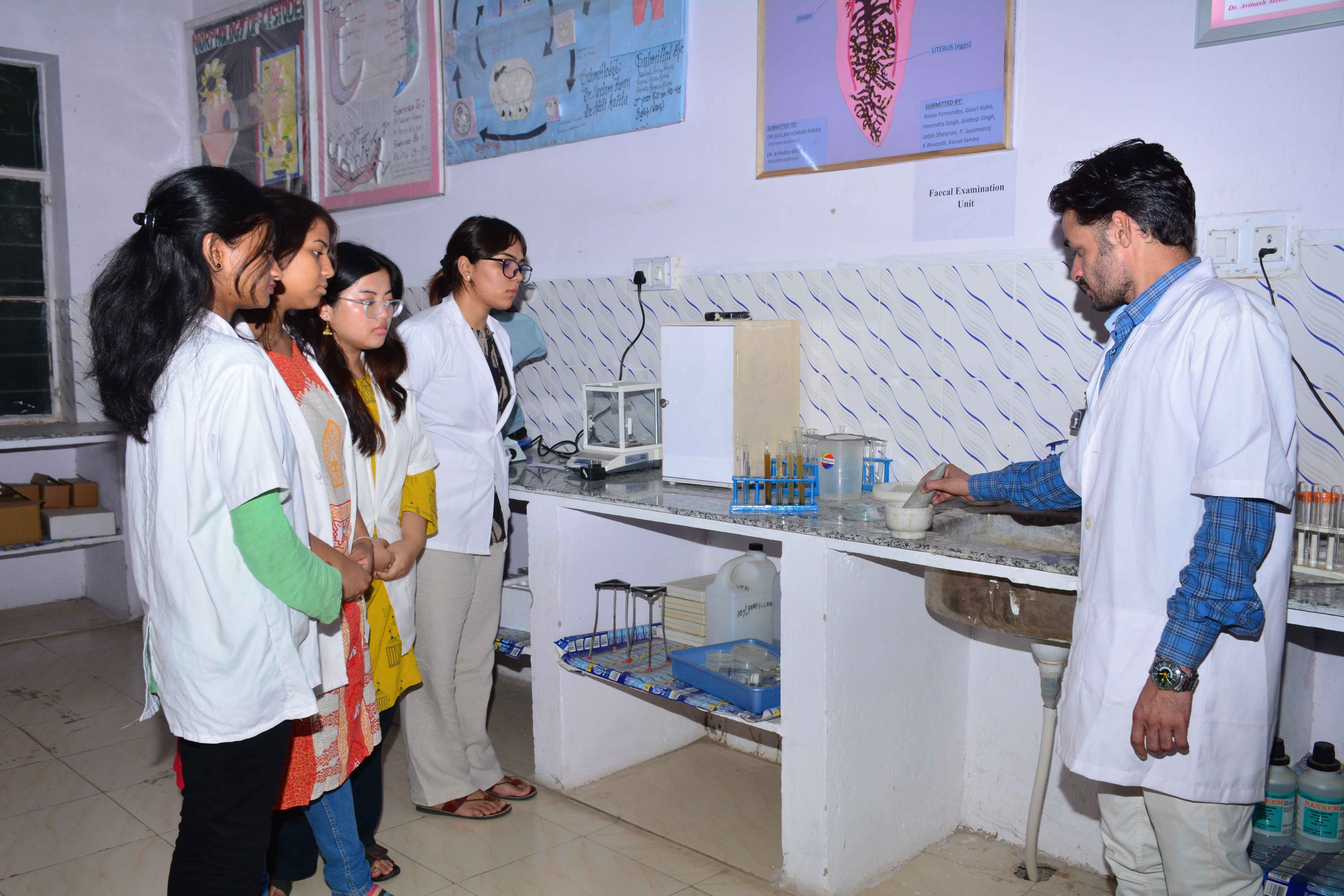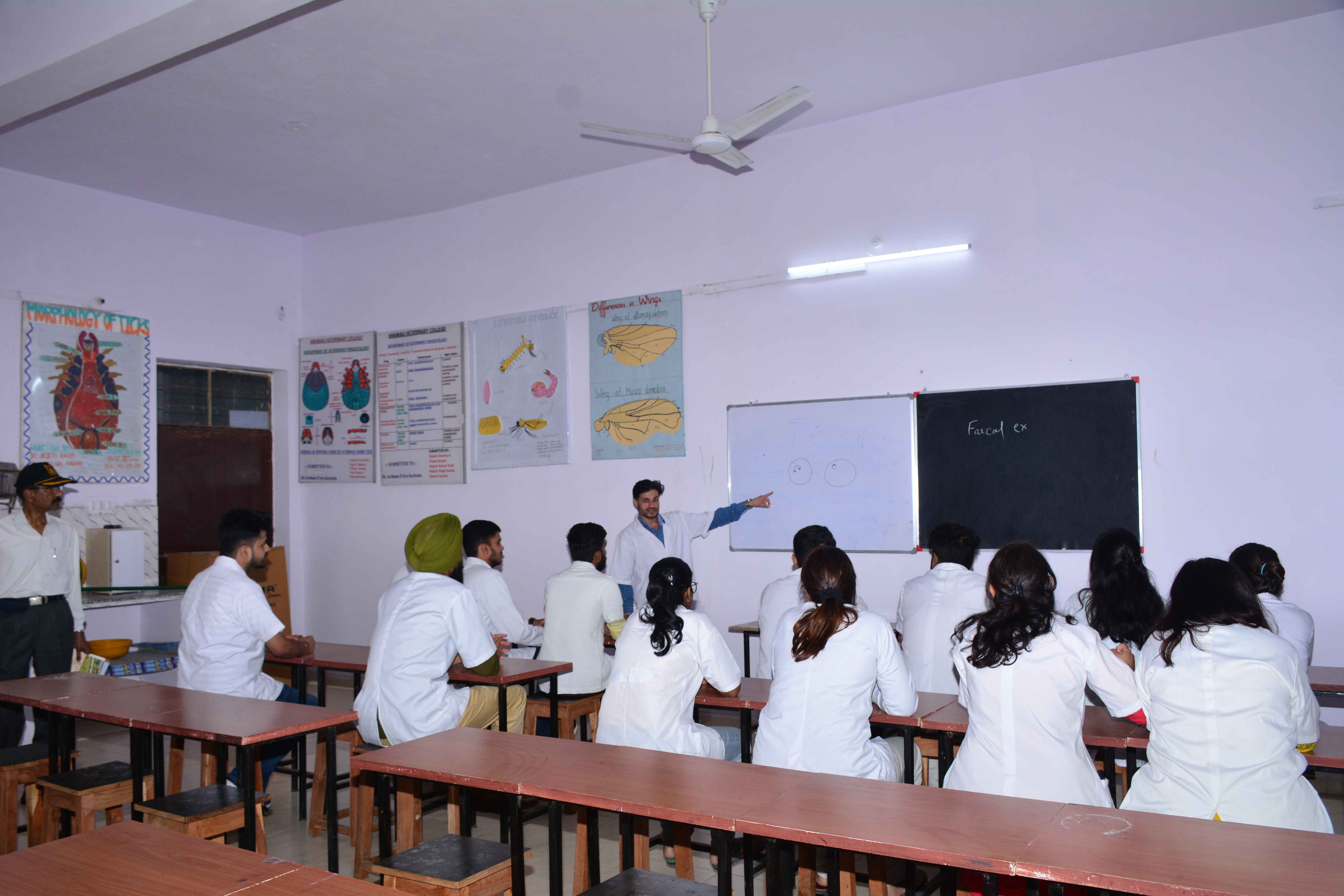

Department of veterinary Parasitology: Parasites significantly cause both morbidity and mortality and hence economic losses to livestock owners. This department offers courses to learn diagnosis, control, treatment and forecasting parasitic diseases in livestock and pets caused by protozoan, helminth and insect parasites. Practical training is imparted for identification of parasites and clinical examination of fecal, blood samples for parasitic infections in VCC and Animal Farm of the college. the department also participates in clinical cams organized by VCC.
The Department has the following sanctioned strength of Faculty:
Professor - 1
Associate Professor – 1
Assistant Professors – 2
S.No.
|
Name
|
Designation
|
Qualification
|
Service Period at AVC
|
Photo
|
Biodata |
|
01
|
Dr. Neelam Kumari Faran
|
Assistant Professor
|
B.V. Sc & AH, M.V.Sc
|
31.03.2017 to till Continue
|
 |
Biodata |
|
02
|
Dr. Vikram Punia
|
Assistant Professor
|
B.V.Sc & AH, M.V.Sc and PhD
|
01.02.2024 to till Continue
|
 |
Biodata |
COURSES AND SYLLABI
THEORY
UNIT- 1 (GENERAL VETERINARY PARASITOLOGY)
Parasitology: Introduction, Important historical landmarks, importance of parasitology in veterinary curriculum. Types of parasites (ecto, endo, hyper, obligatory, facultative, stenoxenous, euryxenous, monoxenous, heteroxenous, histozoic, coelozoic, temporary, permanent, pseudo, aberrant, incidental, opportunistic, zoonotic, protelean etc.). Types of hosts (definitive, intermediate, reservoir, paratenic, natural, unnatural, etc.) and vectors. Types of animal associations (symbiosis, phoresy, commensalism, parasitism, mutualism and predatorism). Modes of transmission of parasites and methods of dissemination of the infective stages of the parasites. International Code of Zoological Nomenclature: Rules and regulations, Standard Nomenclature of Animal Parasitic Diseases (SNOAPAD). Immunity against parasitic infectionsorinfestations, natural and acquired immunity, premunity, sterile immunity, autoimmunity, passive immunity, concomitant immunity and immune evasion by parasites. General harmful effects of parasites including various tissue reactions caused by parasites. General control measures against parasites. Characters of various phyla of parasites.
UNIT-2 (TREMATODES AND CESTODES OF VETERINARY IMPORTANCE)
Trematodes: Introduction, general account and classification, general life cycle of trematodes with morphological features of their developmental stages. Important morphological features, life cycles, modes of transmission, pathogenesis, epidemiology, diagnosis and general control measures (including chemo- and immuno-prophylaxis) of the following trematode parasites: Liver flukes (Fasciola, Dicrocoelium and Opisthorchis), intestinal flukes (Fasciolopsis). Blood flukes causing nasal schistosomosis (Schistosoma nasalis), visceral schistosomosis (S. spindale, S. indicum, S. incognitum) and cercarial dermatitis. Paramphistomes (Paramphistomum, Cotylophoron, Calicophoron, Gigantocotyle, Gastrothylax, Fischoederius,Carmyerius, Gastrodiscus, Gastrodiscoides and Pseudodiscus). Paragonimus, Prosthogonimus and Echinostomes. Cestodes: Introduction, general account and classification, general life cycle of cestodes with morphological features of their developmental stages (Metacestodes). Important morphological features, life cycles, modes of transmission, pathogenesis, epidemiology, diagnosis and management of the following cestode parasites: Equine tape worms (Anoplocephala, Paranoplocephala) and ruminant tape worms (Moniezia, Avitellina, Stilesia,Thysaniezia). Dog tape worms (Dipylidium, Taenia, Echinococcus). Poultry tape worms (Davainea, Cotugnia, Raillietina, Amoebotaenia, Choanotaenia and Hymenolepis. Broad fish tapeworm (Diphyllobothrium) and Spirometra.
UNIT-3 (NEMATODES OF VETERINARY IMPORTANCE)
Nematodes: Introduction, general account and classification, general life cycle of nematodes with morphological features of their developmental stages. Important morphological features, life cycles, modes of transmission, pathogenesis, epidemiology, diagnosis and management of the following nematode parasites: Ascaris, Parascaris, Toxocara, Toxascaris, Ascaridia, Heterakis and Oxyuris. Strongyloides, Strongylus, Chabertia, Syngamus and Oesophagostomum. Kidney worms (Stephanurus and Dioctophyma), hook worms (Ancylostoma and Bunostomum). Trichostrongylus, Ostertagia, Cooperia, Nematodirus, Haemonchus and Mecistocirrus. Habronema, Draschia, Thelazia, Spirocerca, Gongylonema, Physaloptera and Gnathostoma. Dirofilaria, Parafilaria, Onchocerca, Setaria and Stephanofilaria. Lung worms (Dictyocaulus, Muellerius, Protostrongylus and Metastrongylus). Guinea worm (Dracunculus), Trichinella, Trichuris, Capillaria. Acanthocephala (Macracanthorhynchus). Study of anthelmintic resistance and its types.
UNIT-4 (ARTHROPODS OF VETERINARY IMPORTANCE)
Arthropods: Introduction, general account and classification, general life cycle of arthropods with morphological features of their developmental stages. Important morphological features, general bionomics, life cycle, vector potentiality, pathogenesis and control of following arthropods affecting animals and birds: Bugs (Cimex). Biting midges (Culicoides), black flies (Simulium), sandflies (Phlebotomus), mosquitoes (Culex, Anopheles and Aedes). Horse flies (Tabanus), Haematopota and Chrysops. Musca, Stomoxys, Haematobia and Sarcophaga. Warbles (Hypoderma), stomach bots (Gasterophilus,Cobboldia), nasal bots (Oestrus ovis,Cephalopina), Bottle flies (Calliphora, Lucilia, Chrysomya), myiasis. Hippobosca, Melophagus, Pseudolynchia. Lice (Haematopinus, Linognathus, Trichodectes, Damalinia, Menopon, Lipeurus, Menacanthus and Heterodoxus). Fleas (Ctenocephalides, Echidnophaga, Xenopsylla, Pulex). Arachnids : General account, soft ticks (Argas, Ornithodoros and Otobius). Hard ticks (Hyalomma, Haemaphysalis, Rhipicephalus (Boophilus), Dermacentor, Ixodes and mblyomma). Mites (Dermanyssus, Ornithonyssus, Demodex, Notoedres, Sarcoptes, Psoroptes, Chorioptes, Cnemidocoptes and Otodectes). Pentasomida (Linguatula). Study of insecticideoracaricide resistance.
UNIT-5 (PROTOZOA OF VETERINARY IMPORTANCE)
Introduction, general account and classification, general life cycle of protozoa with morphological features of their developmental stages. Differentiation from bacteria and rickettsia. Important morphological features, life cycles, modes of transmission, pathogenesis, epidemiology, diagnosis and general control measures (including chemo- and immunoprophylaxis) of the following protozoan parasites of veterinary and zoonotic importance : Leishmania (Visceral and cutaneous leishmanosis), Trypanosoma (T. evansi, T. theileri, T. equiperdum). Trichomonas (Bovine and avian trichomonosis). Histomonas (Black head in turkeys). Entamoeba, Giardia and Balantidium spp, Coccidia and coccidiosis of poultry and domestic animals. Cyst forming coccidia (Toxoplasma, Sarcocystis and Neospora caninum) and Cryptosporidium. Malarial parasites of animals and poultry (Plasmodium, Haemoproteus and Leucocytozoon). Piroplasms (Babesia, Theileria) and Hepatozoon. Anaplasma and Ehrlichia Resistance to antiprotozoals.
PRACTICAL
UNIT- 1 (GENERAL VETERINARY PARASITOLOGY)
Demonstration of the types of final and intermediate hosts. Demonstration of different organsortissues of the hosts affected with endo-and ectoparasites. Visit to Post Mortem Hall to acquaint with different organs of animals affected with parasites. Demonstration of specific parasitic lesions caused by endo- and ectoparasites. Faecal examination techniques, egg counts, examination of faecal samples for the trematode, cestode, nematode eggs and protozoan cystsoroocystsortrophozoites. Demonstration of faecal culturing techniques. Methods of collection, fixation, preservation, staining and mounting of various types of parasites. Blood smear preparation: Wet, thin and thick smears. Staining of blood smears for demonstration of microfilariae and haemoprotozoan parasites. Collection and examination of skin scrapings for mites. Examination of urine samples and nasal washings for parasitic findings.
UNIT-2 (TREMATODES AND CESTODES OF VETERINARY IMPORTANCE)
Study of morphological characters of adults and developmental stages of the following trematodes and cestodes: Fasciola, Fasciolopsis, Dicrocoelium, Opisthorchis, Schistosoma, Paragonimus, Prosthogonimus, Echinostomes, Paramphistomes (Paramphistomum, Cotylophoron, Gigantocotyle, Gastrothylax, Fischoederius, Gastrodiscus, Gastrodiscoides and Pseudodiscus). Anoplocephala, Paranoplocephala, Moniezia, Avitellina, Stilesia, Davainea, Cotugnia, Raillietina, Amoebotaenia, Choanotaenia, Hymenolepis, Dipylidium, Taenia, Echinococcus, Diphyllobothrium and Spirometra. Demonstration of gross and microscopic lesions of parasites.
UNIT-3 (NEMATODES OF VETERINARY IMPORTANCE)
Study of morphological characters of adults and developmental stages of the following nematodes : Ascaris, Parascaris, Toxocara, Toxascaris, Ascaridia, Heterakis, Oxyuris, Strongyloides, Strongylus, Chabertia, Syngamus and Oesophagostomum. Stephanurus, Dioctophyma, Ancylostoma, Bunostomum, Ostertagia, Trichostrongylus, Cooperia, Nematodirus, Haemonchus and Mecistocirrus. Habronema, Draschia, Thelazia, Spirocerca, Gongylonema, Physaloptera, Gnathostoma, Dirofilaria, Parafilaria, Onchocerca, Setaria, Stephanofilaria, Dictyocaulus, Muellerius, Protostrongylus, Metastrongylus, Dracunculus, Trichinella, Trichuris, Capillaria and Macracanthorhynchus. Demonstration of gross and microscopic lesions of parasites.
UNIT-4 (ARTHROPODS OF VETERINARY IMPORTANCE)
Study of morphological characters of adults and life cycle stages of the following arthropods : Culicoides, Simulium, Phlebotomus, Cimex, Culex, Anopheles, Aedes, Tabanus, Haematopota and Chrysops Musca, Stomoxys, Haematobia, Gasterophilus, Hypoderma, Oestrus ovis, bottle flies, Sarchophaga, Hippobosca, Melophagus and Pseudolynchia. Trichodectes, Menopon, Menacanthus, Lipeurus, Haematopinus, Linognathus and Damalinia Xenopsylla, Ctenocephalides and Echidnophaga.Argas, Ornithodoros, Otobius, Ixodes , Hyalomma, Rhipicephalus (Boophilus), Haemaphysalis, Dermacentor and Amblyomma. Dermanyssus, Ornithonyssus, Demodex, Notoedres, Sarcoptes, Psoroptes, Chorioptes, Cnemidocoptes, Otodectes and Pentastomida. Demonstration of gross and microscopic lesions of parasites.
UNIT-5 (PROTOZOA OF VETERINARY IMPORTANCE)
Study of morphological characters of different stages of following protozoan parasites: Leishmania, Trypanosoma, Trichomonas, Histomonas, Entamoeba, Balantidium, Giardia, Eimeria, Isospora, Sarcocystis , Toxoplasma and Cryptosporidium. Plasmodium, Haemoproteus and Leucocytozoon. Babesia, Theileria and Hepatozoon, Rickettsial organism Anaplasma and Ehrlichia. Demonstration of formol ether and Ziehl-Neelson’s staining techniques and other faecal examination techniques. Diagnosis of intestinal protozoan infections by iodine and eosin stain methods. Demonstration of gross and microscopic lesions due to protozoan parasites. Demonstration of Haemoproteus columbae in the blood. Demonstration of sporulation for diagnosis of coccidian parasites.
ANNUAL EXAMINATION
PAPERS UNITS MAXIMUM MARKS WEIGHTAGE
THEORY
Paper-I 1, 2 and 3 100 20
Paper-II 4 and 5 100 20
PRACTICAL
Paper-I 1, 2 and 3 60 20
Paper - II 4 and 5 60 20
INTERNAL ASSESSMENT 20